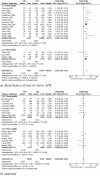Episodes of falling among elderly people: a systematic review and meta-analysis of social and demographic pre-disposing characteristics
- PMID: 21049218
- PMCID: PMC2954741
- DOI: 10.1590/s1807-59322010000900013
Episodes of falling among elderly people: a systematic review and meta-analysis of social and demographic pre-disposing characteristics
Abstract
Context: The multifactorial nature of falls among elderly people is well-known. Identifying the social-demographic characteristics of elderly people who fall would enable us to define the typical profile of the elderly who are at risk of falling.
Objective: We aimed to isolate studies in which the social-demographic risk factors for falls among the elderly have been evaluated and to carry out a meta-analysis by combining the results of all of these selected studies.
Method: We did a systematic literature review using the key words "accidental fall / numerical data" and "risk factors." Inclusion criteria entailed the selection of articles with the following characteristics: population of subjects aged 60 years or over, falls that took place in everyday life, and social-demographic risk factors for falls.
Results: 3,747 indexed articles published between 1981 and 2007 were identified, and 177 studies with available data were included, of which 129 had data on social-demographic risk factors for falls. Difficulties in activities of daily living (ADL) or in instrumental activities of daily living (IADL) double the risk of falling: The OR and 95% Cl were 2.26 (2.09, 2.45) for disturbance ADL and 2.10 (1.68, 2.64) for IADL. The OR and 95% Cl for Caucasians were 1.68 (0.98 - 2.88) and 0.64 (0.51 - 0.80) for Hispanics. In the subgroup of patients older than eighty, being married protected people from falling with an OR and 95% Cl =0.68 (0.53 - 0.87).
Conclusion: Defining factors that create a risk of falling and protect elderly people from falls using social-demographic characteristics lets us focus on an "at risk" population for which a specific program could be developed.
Figures



Similar articles
-
Multifactorial and multiple component interventions for preventing falls in older people living in the community.Cochrane Database Syst Rev. 2018 Jul 23;7(7):CD012221. doi: 10.1002/14651858.CD012221.pub2. Cochrane Database Syst Rev. 2018. PMID: 30035305 Free PMC article.
-
Systemic pharmacological treatments for chronic plaque psoriasis: a network meta-analysis.Cochrane Database Syst Rev. 2021 Apr 19;4(4):CD011535. doi: 10.1002/14651858.CD011535.pub4. Cochrane Database Syst Rev. 2021. Update in: Cochrane Database Syst Rev. 2022 May 23;5:CD011535. doi: 10.1002/14651858.CD011535.pub5. PMID: 33871055 Free PMC article. Updated.
-
A rapid and systematic review of the clinical effectiveness and cost-effectiveness of paclitaxel, docetaxel, gemcitabine and vinorelbine in non-small-cell lung cancer.Health Technol Assess. 2001;5(32):1-195. doi: 10.3310/hta5320. Health Technol Assess. 2001. PMID: 12065068
-
Cognitive behavioural therapy (CBT) with and without exercise to reduce fear of falling in older people living in the community.Cochrane Database Syst Rev. 2023 Nov 15;11(11):CD014666. doi: 10.1002/14651858.CD014666.pub2. Cochrane Database Syst Rev. 2023. PMID: 37965937 Free PMC article.
-
Behavioral interventions to reduce risk for sexual transmission of HIV among men who have sex with men.Cochrane Database Syst Rev. 2008 Jul 16;(3):CD001230. doi: 10.1002/14651858.CD001230.pub2. Cochrane Database Syst Rev. 2008. PMID: 18646068
Cited by
-
Management of high-energy foot and ankle injuries in the geriatric population.Geriatr Orthop Surg Rehabil. 2012 Mar;3(1):33-44. doi: 10.1177/2151458511436112. Geriatr Orthop Surg Rehabil. 2012. PMID: 23569695 Free PMC article.
-
Analysis of Fall Risk Factors in an Aging Population Living in Long-Term Care Institutions in SPAIN: A Retrospective Cohort Study.Int J Environ Res Public Health. 2020 Oct 3;17(19):7234. doi: 10.3390/ijerph17197234. Int J Environ Res Public Health. 2020. PMID: 33022932 Free PMC article.
-
Instrumental activities of daily living staging as a possible clinical tool for falls risk assessment in physical medicine and rehabilitation.PM R. 2014 Apr;6(4):316-23; quiz 323. doi: 10.1016/j.pmrj.2013.10.007. Epub 2013 Oct 17. PM R. 2014. PMID: 24140738 Free PMC article.
-
Risk factors for falls among older adults in India: A systematic review and meta-analysis.Health Sci Rep. 2022 Jun 21;5(4):e637. doi: 10.1002/hsr2.637. eCollection 2022 Jul. Health Sci Rep. 2022. PMID: 35774830 Free PMC article.
-
Characteristics of patients who stop falling after a risk-based multidisciplinary intervention initiated in a geriatric day hospital.J Nutr Health Aging. 2013 Feb;17(2):199-204. doi: 10.1007/s12603-012-0416-2. J Nutr Health Aging. 2013. PMID: 23364503
References
-
- Prudham D, Evans J. Factors associated with falls in the elderly: a community study. Age Ageing. 1981;10:141–146. - PubMed
-
- Perry BC. Falls among the elderly living in high-rise appartments. J Fam Pract. 1982;14:1069–1073. - PubMed
-
- Tinetti ME, Speechley M. Prevention of falls among the elderly. N Engl J Med. 1989;320:1055–1059. 10.1056/NEJM198904203201606 - DOI - PubMed
-
- Oakley A, Dawson MF, Holland J, Arnold S, Cryer C, Doyle Y, et al. Preventing falls and subsequent injury in older people. Qual Health Care. 1996;5:243–249. 10.1136/qshc.5.4.243 - DOI - PMC - PubMed
-
- Rivara FP, Grossman DC, Cummings P. Injury prevention. First of two parts. N Engl J Med. 1997;337:543–548. - PubMed
Publication types
MeSH terms
LinkOut - more resources
Full Text Sources
Medical

